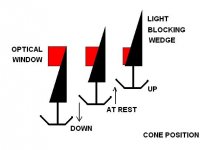In short, yes. That's why I proposed this here.Do you suppose your matrix of photodetectors will have and order of magnitude less distortion (that is, will be more precisely linear) than a $200 woofer that is the product of 75 years of ardent development to make it linear?
This is true, one must be concerned with resolution. But I have seen some recent data that seems to suggest that these photoresistors are quite linear for the middle 90% of their range. This is why I proposed an overlapping array of 2 or more columns/rows. This should help to average out the nonlinearities and provide increased resolution.the problem with such photo-sensors would probabely be to achieve a sufficient dynamic range -or, the other way round- sufficient resolution.
Light has some nice qualities (light weight, fast...) and easy to speculate about using it. But the complexities of controlling it in a highly linear fashion (linear enough to reduce the distortion of a driver) and tied perfectly to the motion of a vibrating piece of cardboard that can move an inch in-and-out, are very great.
Ben
Ben
For any type of feedback sensor:
What should the bandwidth of the feedback system be?
Let's normalize on 100Hz output from the sub.
What should the bandwidth of the feedback system be?
Let's normalize on 100Hz output from the sub.
CharlieLaub
CdS photoresistor detectors are too slow...35mS typical rise time or more.
Had an idea last year...wedge sliding across an OPT101
PHOTO DIODE SIZE: 0.090 x 0.090 inch
Enough light and a fast bandwidth...low gain.
Have not tried it yet...need to find my micrometer for measurement.
It is on the list.
🙂
CdS photoresistor detectors are too slow...35mS typical rise time or more.
Had an idea last year...wedge sliding across an OPT101
PHOTO DIODE SIZE: 0.090 x 0.090 inch
Enough light and a fast bandwidth...low gain.
Have not tried it yet...need to find my micrometer for measurement.
It is on the list.
🙂
Attachments
Last edited:
- Status
- Not open for further replies.
